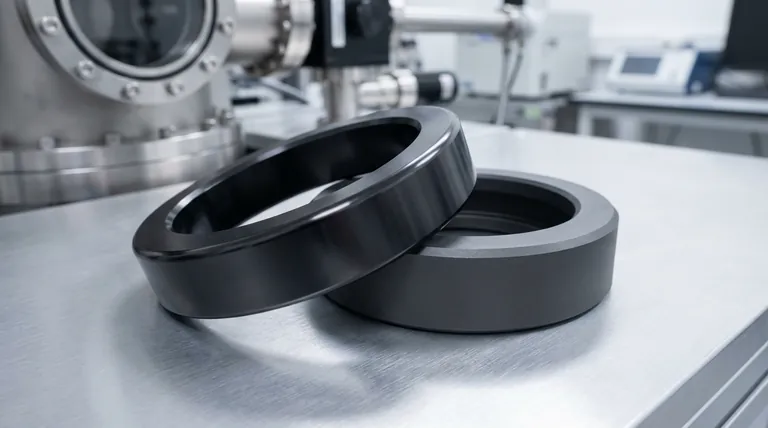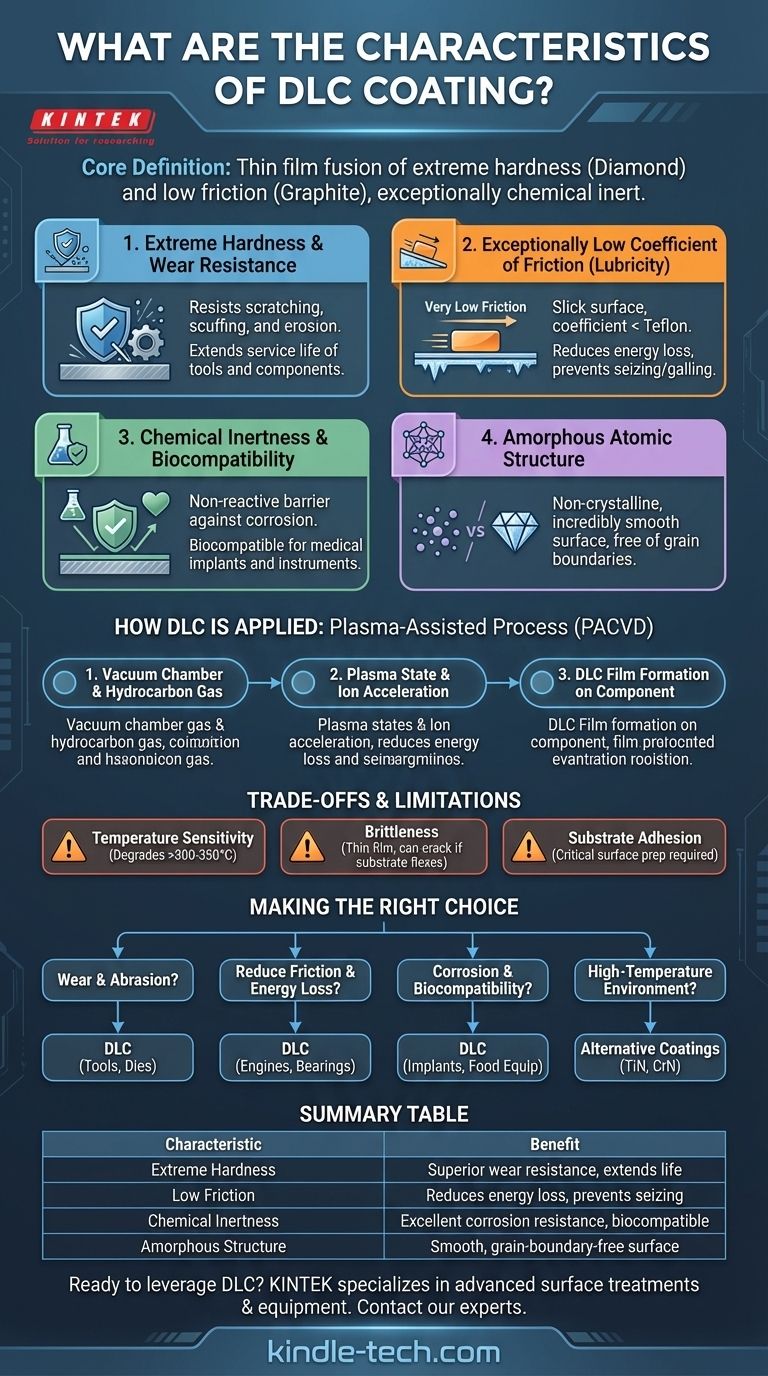At its core, a Diamond-Like Carbon (DLC) coating is a thin film material defined by a unique combination of extreme hardness, exceptionally low friction, and chemical inertness. This advanced surface treatment is created by depositing a layer of amorphous carbon—carbon atoms without a rigid crystal structure—onto a component. The process, often involving hydrocarbon gases in a plasma environment, creates a surface that shares properties with both natural diamond and graphite.
The defining value of DLC is not just one characteristic, but its unique fusion of two seemingly contradictory properties: the extreme hardness of diamond and the low-friction lubricity of graphite. This makes it an ideal solution for improving the durability and efficiency of critical components.

The Core Properties of DLC Explained
To truly understand DLC, we must break down its principal characteristics and what they mean in a practical, engineering context.
Extreme Hardness and Wear Resistance
The most well-known property of DLC is its hardness, which provides outstanding protection against abrasive and adhesive wear.
The dense network of bonded carbon atoms makes the surface highly resistant to scratching, scuffing, and erosion. This dramatically extends the service life of tools and components, from industrial cutting bits to automotive engine parts.
Exceptionally Low Coefficient of Friction
DLC coatings are incredibly slick, with a coefficient of friction often lower than Teflon. This property is sometimes referred to as high lubricity.
This slipperiness reduces the energy required for parts to slide against each other, minimizing heat generation and preventing components from seizing or galling under load. This is critical for high-performance moving parts like pistons, bearings, and gears.
Chemical Inertness and Biocompatibility
The carbon structure of DLC makes it a highly non-reactive material. It acts as an excellent barrier, protecting the underlying substrate from corrosion and chemical attack.
Furthermore, this inertness makes most forms of DLC biocompatible, meaning it does not provoke an adverse reaction when in contact with living tissue. This has made it a go-to coating for medical implants and surgical instruments.
Amorphous Atomic Structure
Unlike diamond, which has a rigid crystalline lattice, DLC is amorphous. This means its atoms lack a long-range, ordered structure.
This non-crystalline nature results in an incredibly smooth surface finish free of grain boundaries, which can be potential weak points or initiation sites for cracks and corrosion in other materials.
How DLC Is Applied
Understanding the application process helps clarify some of the coating's characteristics and limitations.
The Plasma-Assisted Process
DLC is typically applied using a vacuum deposition process, such as Plasma-Assisted Chemical Vapor Deposition (PACVD).
In this method, a hydrocarbon gas (a source of carbon and hydrogen atoms) is introduced into a vacuum chamber and energized into a plasma state.
Deposition and Recombination
The ions from this plasma are accelerated towards the target component. As noted, they essentially "spray" the surface.
Once on the surface, these carbon and hydrogen ions bond and recombine to form the thin, hard, and slick amorphous carbon film we identify as DLC.
Understanding the Trade-offs and Limitations
No engineering solution is perfect. Objectivity requires acknowledging where DLC may not be the optimal choice.
Temperature Sensitivity
Standard DLC coatings can begin to degrade and lose their beneficial properties at temperatures above 300-350°C (approx. 570-660°F). In high-heat applications, other ceramic coatings may be more suitable.
Coating Thickness and Brittleness
DLC is a very thin film, typically only a few microns thick. While incredibly hard, it is also brittle. If the underlying substrate flexes or deforms too much, the coating can crack or delaminate.
Substrate Adhesion is Critical
The performance of the coating is entirely dependent on its ability to bond to the substrate material. Improper surface preparation is a primary cause of coating failure, making it a critical step in the application process.
Making the Right Choice for Your Application
Selecting a coating requires matching its properties to your primary engineering goal.
- If your primary focus is maximizing wear and abrasion resistance: DLC is a premier choice, especially in applications where low friction is also a benefit, such as on cutting tools or forming dies.
- If your primary focus is reducing friction and energy loss: The high lubricity of DLC makes it ideal for internal engine components, bearings, and any sliding mechanical system.
- If your primary focus is corrosion protection or biocompatibility: DLC serves as an excellent, impenetrable barrier for medical implants, food processing equipment, and components exposed to chemicals.
- If your primary focus is performance in a high-temperature environment: You should carefully evaluate the operating temperatures and consider alternative ceramic coatings like Titanium Nitride (TiN) or Chromium Nitride (CrN).
Ultimately, understanding these core characteristics allows you to leverage DLC not just as a coating, but as a strategic engineering solution to a specific problem.
Summary Table:
| Characteristic | Benefit |
|---|---|
| Extreme Hardness | Superior wear resistance, extends component life |
| Low Friction | Reduces energy loss, prevents seizing/galling |
| Chemical Inertness | Excellent corrosion resistance and biocompatibility |
| Amorphous Structure | Smooth, grain-boundary-free surface finish |
Ready to leverage DLC coating for your critical components?
KINTEK specializes in advanced surface treatments and lab equipment. Our expertise can help you apply DLC coatings to enhance the durability, efficiency, and performance of your tools, engine parts, medical devices, and more.
Contact our experts today to discuss how DLC coating can solve your specific engineering challenges!
Visual Guide

Related Products
- Custom CVD Diamond Coating for Lab Applications
- CVD Diamond Cutting Tool Blanks for Precision Machining
- RF PECVD System Radio Frequency Plasma-Enhanced Chemical Vapor Deposition RF PECVD
- Hydrophilic Carbon Paper TGPH060 for Battery Lab Applications
- Cylindrical Resonator MPCVD Machine System Reactor for Microwave Plasma Chemical Vapor Deposition and Lab Diamond Growth
People Also Ask
- How are tools coated with diamond? Achieve Superior Hardness and Low Friction for Your Tools
- Is diamond coating worth it? Maximize Component Life and Performance
- What are diamond coated films? Enhance Materials with Super-Hard, Transparent Layers
- What is CVD diamond coating? Grow a Super-Hard, High-Performance Diamond Layer
- How long does diamond coating last? Maximize Lifespan with the Right Coating for Your Application










